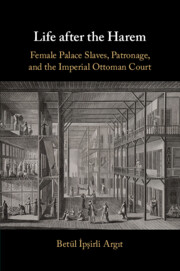Book contents
- Life after the Harem
- Life after the Harem
- Copyright page
- Dedication
- Contents
- Illustrations
- Maps
- Graphs
- Tables
- Acknowledgments
- Note on Usage
- Abbreviations
- Introduction
- 1 The Imperial Harem and Its Residents
- 2 Departure from the Imperial Palace and Changing Relationships with the Imperial Court
- 3 Marriage Patterns
- 4 Residential Districts and Relations with Society
- 5 Material World: Fortunes and Possessions
- 6 Charitable Activities: Architectural Patronage and Endowments
- Conclusion
- Appendix Residential Neighborhoods of Palace Women in intra muros Istanbul
- Bibliography
- Index
4 - Residential Districts and Relations with Society
Published online by Cambridge University Press: 08 October 2020
- Life after the Harem
- Life after the Harem
- Copyright page
- Dedication
- Contents
- Illustrations
- Maps
- Graphs
- Tables
- Acknowledgments
- Note on Usage
- Abbreviations
- Introduction
- 1 The Imperial Harem and Its Residents
- 2 Departure from the Imperial Palace and Changing Relationships with the Imperial Court
- 3 Marriage Patterns
- 4 Residential Districts and Relations with Society
- 5 Material World: Fortunes and Possessions
- 6 Charitable Activities: Architectural Patronage and Endowments
- Conclusion
- Appendix Residential Neighborhoods of Palace Women in intra muros Istanbul
- Bibliography
- Index
Summary
When manumitted female palace slaves left the imperial palaces, they settled in various parts of the empire as either married or single persons with their palace identity. The women’s former status in the harem hierarchy, and the extent of their palace affiliation, determined (at least to some extent) where they resided. Chapter 4 is devoted to a study of the residential districts of manumitted female palace slaves, with a view to tracing the impact of household affiliation and of status on their residential patterns. Following their departure from the imperial palaces, manumitted female palace slaves began a new life in various parts of the empire, but mainly in Istanbul. The chapter demonstrates that households composed of palace women and their husbands were located at certain distances to the palace. Having established the residential pattern of manumitted female palace slaves, who were familiar with the imperial court culture and lived in society with their palace identity, the chapter explores the place of these women in society. Through an analysis of court records, the chapter demonstrates how palace-affiliated women integrated into society and developed social and communal relationships, especially with residents of the neighborhoods in which they lived.
- Type
- Chapter
- Information
- Life after the HaremFemale Palace Slaves, Patronage and the Imperial Ottoman Court, pp. 136 - 161Publisher: Cambridge University PressPrint publication year: 2020



